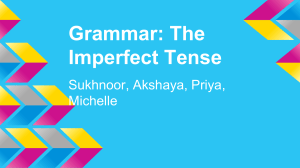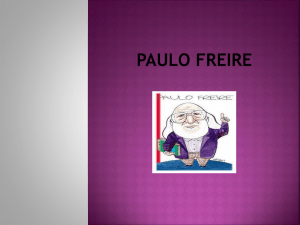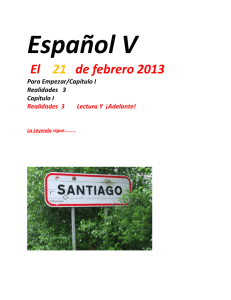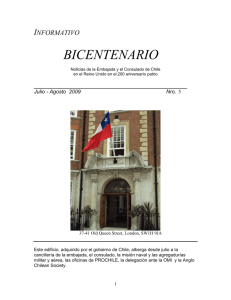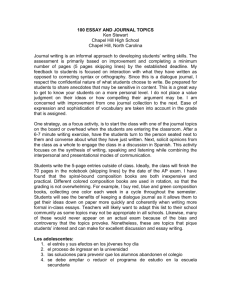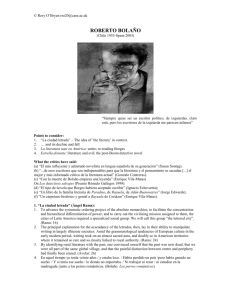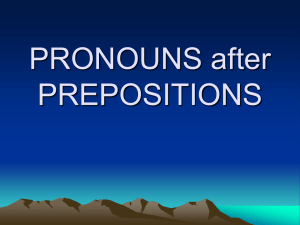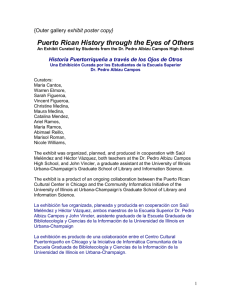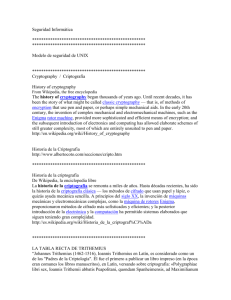Guía de Estudio EEES Comunicación en Inglés - Puerto Rico
advertisement
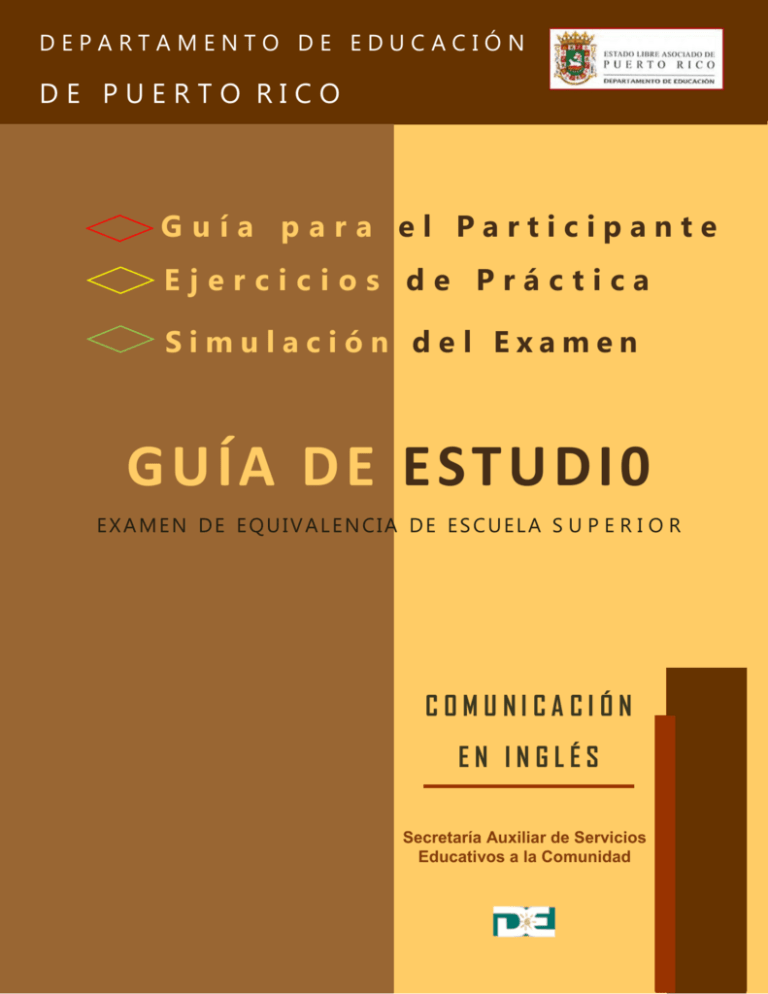
DEPARTAMENTO DE EDUCACIÓN DE PUERTO RICO Guía para el Participante Ejercicios de Práctica Simulación del Examen GUÍA DE ESTUDI0 EXAMEN DE EQUIVALENCIA DE ESCUELA S U P E R I O R COMUNICACIÓN EN INGLÉS Secretaría Auxiliar de Servicios Educativos a la Comunidad GUÍA DE ESTUDI0 EXAMEN DE EQUIVALENCIA DE ESCUELA S U P E R I O R PROGRAMA DE EDUCACIÓN PARA ADULTOS UNIDAD DE EXÁMENES, DIPLOMAS Y CERTIFICACIONES 2015 DERECHOS RESERVADOS CONFORME A LA LEY DEL DEPARTAMENTO DE EDUCACIÓN DE PUERTO RICO El Departamento de Educación no discrimina de ninguna manera por razón de edad, raza, color, sexo, nacimiento, condición de veterano, ideología política o religiosa, origen o condición social, orientación sexual o identidad de género, discapacidad o impedimento físico o mental; ni por ser víctima de violencia doméstica, agresión sexual o acecho. NOTA ACLARATORIA Para propósitos de carácter legal en relación con el Título VII de la Ley de Derechos Civiles de 1964; la Ley Pública 88-352, 42 USC. 2000 et seq.; la Constitución del Estado Libre Asociado de Puerto Rico; la Carta Circular Núm. 192014-2015, Política pública sobre la equidad de género y su integración al currículo del Departamento de Educación de Puerto Rico como instrumento para promover la dignidad del ser humanos y la igualdad de todos y todas ante la ley; y el principio de economía gramatical y género no marcado de la ortografía española, el uso de los términos facilitador, maestro, director, estudiante, tutor, encargado y cualquier uso que pueda hacer referencia a ambos géneros, incluye tanto al masculino como al femenino. JUNTA EDITORA Prof. Rafael Román Meléndez Secretario del Departamento de Educación Prof. Harry Valentín González Subsecretario para Asuntos Académicos Prof.a Damaris E. Pérez Gullón Secretaria Auxiliar Servicios Educativos a la Comunidad Prof.a Anayantzie Altieri Avilés Directora Programa Educación para Adultos Prof.a Luz M. Torres Ramis de Ayreflor Directora Unidad de Exámenes, Diplomas y Certificaciones La Guía de Estudio para el Examen de Equivalencia de Escuela Superior es el producto de la participación de un equipo de profesionales comprometidos con la educación. Agradecemos a todas las personas que colaboraron en la validación, revisión y edición de este trabajo. En especial agradecemos a: Sra. Nomayra Sánchez Ayudante Especial Secretaría Auxiliar de Servicios Educativos a la Comunidad Prof.a Carmen A. Barreda García Asesora Programa de Educación para Adultos Sr. Ismael Candelaria Medina Auxiliar Administrativo III - Concepto Artístico Unidad de Exámenes, Diplomas y Certificaciones Innovativa Consultores Inc. y su Equipo de Trabajo Marisol Acevedo Rivera Facilitadora docente de Español Distrito de Corozal Rosario González Feliciano Facilitadora docente de Matemáticas Distrito de San Juan II Glory Ann Torres Torres Facilitadora docente de Español Distrito de Corozal Leannette Rullán Calcerrada Facilitadora docente de Ciencias Distrito de Carolina Jovita Flores Palos Facilitadora docente de Inglés Distrito de Corozal Mayra González Lind Facilitadora docente de Estudios Sociales Distrito de Carolina Tabla de Contenido I. ¿Qué es el Examen de Equivalencia de Escuela Superior (EEES)? A. Descripción del examen 3 B. ¿Qué se examina en el EEES? 3 1. Áreas académicas que se evalúan 3 C. Tiempo de duración del EEES 4 D. Formato de los ejercicios 4 E. Resultados del EEES 4 F. Prepararse para tomar los exámenes del EEES: Recomendaciones y consejos prácticos 4 II. Guía de Estudio A. Propósito de la Guía 6 B. ¿Cómo utilizar la Guía de Estudio? 6 C. Descripción del examen de simulación Comunicación en Inglés 8 D. Conceptos / Descripción General / Destrezas 9 E. Examen de Simulación 18 1. Ejercicios de práctica y respuestas 20 2. Ejercicios de simulación 23 F. Respuestas a los ejercicios de simulación 42 III. Referencias A. Referencias de libros 43 B. Referencias electrónicas 44 I. ¿Qué es el Examen de Equivalencia de Escuela Superior (EEES)? A. D e s c r i p c i ó n d e l e x a m e n El Examen de Equivalencia de Escuela Superior es una batería de cinco (5) exámenes que responden al programa del Departamento de Educación de Puerto Rico en las áreas de Comunicación en Español, Comunicación en Inglés, Interacción Social, Razonamiento Científico y Razonamiento Matemático. Este examen evalúa la habilidad cognoscitiva, el aprovechamiento académico y sus destrezas de redacción. El examen está disponible para aquellos adultos como usted que no completaron sus estudios, ofreciéndoles así la oportunidad de obtener el diploma de escuela superior. Este certificado de equivalencia es válido para los patronos de agencias públicas o privadas así como para instituciones que ofrecen estudios universitarios o posgrados. B. ¿Q u é s e e x a m i n a e n e l E E E S ? El EEES tiene como finalidad examinar las habilidades y el aprendizaje desarrollados por el participante a lo largo de su educación básica. Como sabemos, el desarrollo de estas destrezas corresponde al cúmulo de conocimientos adquiridos a través de los años de enseñanza formal y aprendizaje del participante. Esto requiere que dediquen tiempo de repaso y práctica constante como preámbulo al examen, ya que sólo así se recordarán y activarán los contenidos y habilidades adquiridas en su formación. El examen abarca las cinco (5) asignaturas básicas del Programa de Educación para Adultos. 1. Á r e a s a c a d é m i c a s q u e s e e v a l ú a n 3 C. T i e m p o d e d u r a c i ó n d e l e x a m e n El tiempo de duración de cada uno de los cinco (5) exámenes varía según la materia. D. F o r m a t o d e l o s e j e r c i c i o s Los ejercicios del EEES están redactados por áreas temáticas y siguen un formato de pregunta, seguida de alternativas o posibles respuestas. En la prueba se presentan diversos tipos de ejercicios de selección múltiple. Cada ejercicio de selección múltiple ofrece cinco (5) alternativas: A), B), C), D) y E). Entre estas, solamente existe una respuesta CORRECTA que puede estar en cualquier posición entre las alternativas para cada pregunta. A todos los ejercicios se les asigna el mismo valor, aun a los más difíciles. E. R e s u l t a d o s d e l E E E S Aunque cada examen se califica de manera independiente, para obtener el diploma de equivalencia de escuela superior tiene que aprobar los cinco exámenes. F. P r e p a r a r s e p a r a t o m a r l o s e x á m e n e s d e l E E E S Para poder estudiar de manera apropiada y lograr los mejores resultados en este examen, siga estas recomendaciones y consejos prácticos: • • • • • • • • Elija un buen horario para usted. Elija un lugar silencioso e iluminado. Estudie por lo menos 2 horas diarias. Lea y practique. Tome descansos breves. No estudie la noche antes. Descanse y duerma bien. Desayune bien. 4 • • • • • • Salga a tiempo, trate de llegar 20 minutos antes del examen. Si el horario del examen lo amerita, lleve meriendas o almuerzos. Estudie la materia más de una vez. Tome mucha agua mientras estudia. Mantenga el teléfono o cualquier dispositivo electrónico apagado mientras estudia. No dude de su capacidad ni de sus conocimientos el día del examen. 5 II. Guía de estudio A. P r o p ó s i t o d e l a G u í a d e E s t u d i o La EEES cubre cinco áreas académicas, conocidas como áreas medulares de la enseñanza. Esta guía presenta información didáctica, y explicaciones de cada área con el propósito de brindar al participante una idea clara de cómo se organiza y estructura el contenido de la prueba del EEES. Así, la guía contiene información relacionada con el contenido del examen, ejercicios de práctica, exámenes simulados y referencias para facilitar el estudio de cada concepto a evaluarse en la asignatura, de forma que le facilite el prepararse para tomar el Examen y aprobarlo con éxito. B. ¿ C ó m o u t i l i z a r la Guía de Estudio? La Guía de Estudio que aquí se presenta le servirá como una herramienta didáctica que facilitará su aprendizaje. La puede utilizar de manera autodidacta o con la ayuda de sus maestros, de manera que pueda reforzar y aumentar su comprensión sobre cierta información académica en las materias básicas. Por ello, ponemos a su alcance material de estudio con el propósito de que pueda presentar su Examen de Equivalencia de Escuela Superior en la forma adecuada y con mayores probabilidades de éxito. Comience leyendo cuidadosamente la tabla de contenido de forma que conozca las secciones que contiene la guía. Una vez termine con la tabla de contenido, así como la información de las secciones I y II, pase a leer detenidamente toda la información contenida en la guía. Es decir: 1. Estudie primero la descripción del examen según la materia específica. Prosiga con la Tabla de conceptos que resume todos los conceptos que se trabajarán en el examen, una descripción general de cada concepto, así como el contenido específico de las destrezas que debe dominar. 2. Luego utilice los instrumentos y ejercicios de práctica para diagnosticar cuánto más debe estudiar para dominar a cabalidad cada concepto del EEES. 6 Analice la forma en la que están estructurados los ejemplos, y la forma de responder los ejercicios. Realice las actividades que se sugieren, esto permitirá mejorar el proceso de análisis, así como las habilidades matemáticas y lectoras. Conteste los ejercicios de práctica que se incluyen en la guía, hasta que se sienta preparado. Consulte diversas fuentes bibliográficas cuando tenga duda en algún tema. 3. Proceda a contestar el examen de simulación. Es importante que lea atenta y detenidamente las recomendaciones para resolver los ejercicios del examen de simulación que aquí se le indican. No consulte el anejo de respuestas hasta que se haya contestado el instrumento de práctica. Compare las respuestas con las claves que se incluyen en el anejo. En caso de que alguna respuesta esté incorrecta, regrese al ejercicio y busque otra vía de solución. Es importante utilizar las referencias provistas para cada concepto y estudiar el contenido específico de cada material. Puede conseguir ayuda adicional para estudiar el contenido de cada prueba del EEES a través del Programa de Educación para Adultos de cada Región Educativa o en las Oficinas Centrales del Departamento de Educación. 7 C. D e s c r i p c i ó n d e l e x a m e n d e s i m u l a c i ó n : Comunicacíon en Inglés El examen de simulación de Comunicación en Inglés se presenta en tres (3) secciones, con sus correspondientes conceptos, según aparecen en la Tabla, a saber: 1ra. - Language and Grammar 2da. - Reading Comprehension 3ra. - Indirect Writing El propósito de este examen de simulación de Comunicación en Inglés es medir la comprensión lectora básica en inglés. Además mide el dominio que el participante tiene de los elementos básicos del idioma, es decir, si es capaz de utilizarlo adecuadamente. El examen de simulación incluye 50 preguntas de selección múltiple relacionadas a conceptos como los siguientes: partes de la oración, vocabulario en contexto, oraciones incompletas, relaciones de sentido, sinónimos, textos literarios e informativos, el texto como unidad de sentido, conectores lógicos y redacción indirecta. Después de la tabla de conceptos que sigue a continuación, se ofrece el examen de simulación que le brindará al participante una experiencia similar al examen de equivalencia de Comunicación en Inglés. 8 D. TABLA DE CONCEPTOS – COMUNICACIÓN EN INGLÉS SECTION 1: LANGUAGE USE AND GRAMMAR Concepts 1. Language use/usage General Description Skills/Competencies Language use refers to knowledge of Recognize vocabulary grammatical form correctness for in context. communication purposes. Language usage refers to the rules for Apply the correct use making language, i.e. the structures of prepositions and used. It can be compared to use, which pronouns. considers the communicative meaning of language. For language usage, punctuation rules are very important. Punctuation is the use of spacing, conventional signs and certain typographical devices as aids to the understanding and correct reading, both silently and aloud, of handwritten and printed texts. They are the marks such as periods and commas in writing that make the meaning clear. There are 14 punctuation marks in the English language: the period, question mark, exclamation point, comma, semicolon, colon, dash, hyphen, parentheses, brackets, braces, apostrophe, quotation marks, and ellipses. 9 Recognize correct punctuation and end marks in sentences and questions. Concepts General Description 2. Parts of Speech English words have been traditionally classified into eight lexical categories, or parts of speech (and are still done so in most dictionaries): nouns, pronouns, adjectives, verbs, adverbs, prepositions, conjunctions, and interjections for communication purposes, according to their functions. 1. Noun - any abstract or concrete entity; a person (police officer, Michael), place (coastline, London), thing (necktie, television), idea (happiness), or quality (bravery). 2. Pronoun - a word that substitutes for a noun or noun phrase (them).They are used in place of a noun that has already been mentioned or that is already known, often to avoid repeating the noun. For example: Karen was tired so she went to bed. Carlos took the children with him. Julia’s face was close to mine. Skills/Competencies List the parts of speech. Identify nouns as part of the sentence structure. Apply the correct use of pronouns. Determine subject and verb agreement in sentences and questions. Apply verb tenses correctly. Identify adverbs in a sentence. Recognize adjectives in a sentence. Recognize prepositions of time, 3. Verb – word that describes any action location, and place (walk), occurrence (happen), or state of correctly. being (be) in the sentence. Verbs show the action and verb tenses Select conjunctions indicate the time of the action or state correctly in sentences that being expressed by the verb. In (continue in next page) English, there are three basic tenses: 10 Concepts Skills/Competencies General Description 2. Parts of Speech present, past, and future. (continous from previous page) Present tense - the verb indicates habit or general truth. - I study English every day. Past tense - the verb indicates terminated action. - Two years ago, I studied English New York. Future tense – the verb indicates future action. - I will study English next year Identify interjections in sentences. a a in a 4. Adverb - any word that describes characteristics (qualifier) of an verb, clause, sentence, or other adverb (i. e. very). 5. Adjective - a word that describes a noun. 6. Prepositions – describe a relationship between words in a sentence, they indicate a relationship between two things. There are about 150 prepositions in English. Prepositions are important words. We use individual prepositions more frequently than other individual words. In fact, the prepositions of, to and in are among the ten most frequent words in English. (continue in next page) 11 Concepts General Description 2. Parts of Speech English Preposition Rule: A preposition is followed by a "noun". It is never (continous from followed by a verb. previous page) Prepositions of Place: at, in, on Most frequently used for: • at for a POINT • in for an ENCLOSED SPACE • on for a SURFACE Prepositions of Time: at, in, on. In general, we use: • at for a PRECISE TIME • in for MONTHS, YEARS, CENTURIES and LONG PERIODS • on for DAYS and DATES 7. Conjunction - Any syntactic connector (and) join words or groups of words: or, not, but, for, although, etc. 8. Interjection - a word added to a sentence to convey an emotion or a feelings such as surprise, disgust, joy, excitement, or enthusiasm. 12 Skills/Competencies SECTION 2: READING COMPREHENSION Skills/Competencies Concepts General Description 3. Comprehension and interpretation of literary and informational texts. Reading comprehension refers to: literal comprehension and understanding of what is explicitly stated in the text, or inferential comprehension refers to the understanding of what is implied by the text. Identify vocabulary meaning according to the context. Texts are written for three different purposes: to entertain, as with novels and fictional stories; to persuade, as with articles trying to convince you of a certain point; and to inform, as with encyclopedias, history books, textbooks, and anything made to help you learn different things. Identify main ideas in a selection. Reading for comprehension requires that you be able to understand concepts as follows: 1. Main Ideas - The most important or central idea of a passage. Example: “The yo-yo has appealed to many different cultures during different periods.” 2. Details - Support or explain the main idea. Example: “The yo-yo was invented one thousand years ago in China. It became popular in England, France, and the United States.” 13 Identify the story elements in a selection. Determine supporting ideas in the selection. Identify supporting sentences in a text. Order sequence of events in a series of disarrayed sentences. Recognize the sequence of events. Identify the personality of the characters. Infer the climax of a selection. Concepts General Description Skills/Competencies 3. Sequence of Events - Shows events in the order in which they happened chronologically. 4. Characterization - The process by which the writer reveals the personality of the character. Example: “The impatient boy and quiet girl were both well-mannered and did not disobey their mother.” 5. Climax - The highest point of action in a story. 4. Vocabulary in Context Vocabulary in context refers to the part of a text or statement that surrounds a particular word or passage and determines its meaning. Determine the meaning of unknown words by using context clues. You can find the clues to the meaning of unfamiliar words by examining the context, the words surrounding the unfamiliar word. Recognize correct word order in sentences and questions. Example: The speaker was eloquent, persuading us with her moving stories. When you are able to determine the meaning of an unknown word by reading the words or sentences around it, you are using vocabulary in context. Developing vocabulary in context skills is important because it (continue in next page) 14 Concepts 4. Vocabulary in Context (continous from previous page) General Description allows you to continue reading without stopping to use a dictionary. Context clues are words and phrases in a sentence which help you reason out the meaning of an unfamiliar word. Often you can figure out the meanings of new or unfamiliar vocabulary by paying attention to the surrounding language. You will study four types of context clues that help in defining unknown word. Example: Synonyms, Antonyms, and General Senses. For example, you might not understand the word acerbity, by itself: “The acerbity of the lemon caused the little girl to spit out the bite she had just taken.”; this sentence helps you understand that the general meaning of acerbity must be “bitter or sour”. The context clues "lemon" and "spitting out the bite", which provide more information in the sentence, help you understand what the vocabulary word means. 15 Skills/Competencies SECTION 3: INDIRECT WRITING Concepts Skills/Competencies General Description 5. Indirect Writing Recognize writing strategies improve, revise, or edit the text. to Identification of correct sentence structures, spelling, and grammatical fluency in passages. 6. Sentence structure Sentence structure tells us how many independent and dependent clauses are in a sentence. Topic sentence is the main idea developed about a topic. Determine the topic and concluding sentences of a passage. There are four sentence structures. Identify correct sentence structure in 1. Simple sentences: contain only a text. one independent clause and no subordinate clauses. Example: - I drink coffee. 2. Compound sentences: contain two or more independent clauses and no subordinate clauses. Example: (continue in next page) - She cooked and he cleaned. 16 Concepts 6. Sentence structure (continous from previous page) General Description 3. Complex sentences: contain one independent clause and at least one subordinate clause. Example: - Since I love reading, I have a library card. 4. Compound - complex sentences: contain at least two independent clauses and at least one subordinate clause. Example: - I would have purchased the cheese that you like, but it was too expensive. 17 Skills/Competencies E. E x a m e n d e S i m u l a c i ó n El examen de simulación integra dos tipos de ejercicicios: de práctica y de simulación. 1. E j e r c i c i o s d e p r á c t i c a y r e s p u e s t a s Los ejercicios de práctica responden a cada uno de los conceptos que aparecen en la Tabla correspondiente y se trabajan en el mismo orden. Cada ejercicio de práctica le ofrece información de contenido sobre el tema además de mostrarle un modelo de las instrucciones y ejercicios que aparecerán en el examen del EEES. Asi mismo se presenta una explicación de cómo se llevó a cabo el razonamiento que permitió seleccionar la respuesta elegida. 2. E j e r c i c i o s d e s i m u l a c i ó n y r e s p u e s t a s Los ejercicios de simulación son ejercicios similares a los de práctica y corresponden, también, a los conceptos y las destrezas específicas que se evaluarán en el EEES. Todas las respuestas a los ejercicios de simulación de las distintas materias se encuentran en la sección F que está al final de esta guía, de forma que pueda evaluar su desempeño y prepararse con anticipación para el día del examen de equivalencia. 18 Instrucciones Generales Antes de comenzar a contestar los ejercicios de este examen, siga las instrucciones que se le indican para que pueda utilizar de forma correcta la hoja de contestaciones y se asegure de que su respuesta sea válida. Lea cuidadosamente las recomendaciones que se presentan a continuación. Instrucciones para responder en la hoja de contestaciones: 1. Utilice únicamente un lápiz número 2 para rellenar los espacios. 2. No utilice un lápiz mecánico, bolígrafo, ni tinta. 3. Rellene el espacio completamente con su respuesta. 4. No responda con marcas de cotejo, equis (x) u otras líneas. 5. Evite presionar muy fuerte el lápiz, en caso que desee borrar para cambiar una respuesta borre completamente la marca anterior. 6. No deje respuestas en blanco. 7. No apoye la punta del lápiz en la hoja de contestaciones mientras piensa su respuesta, ni haga marcas innecesarias en la hoja. EJEMPLOS: 19 Ejercicios de Práctica y Respuesta de Comunicación en Inglés Examples: Section 1: Language Use and Grammar Mary is the tallest of all the students. Concepts: I am in the smallest class in the school. *Punctuation and parts of speech vocabulary in context Instructions: You will find incomplete statements. Each statement has one (1) or two (2) blanks. Each blank indicates that a word was omitted. After reading carefully, select the option that best logically completes or is the function of the missing word in the statement. There are five (5) options to choose from with letters a, b, c, d, and e after each statement. Language use refers to knowledge of grammatical form correctness for communication purposes. It includes appropriate use of punctuation rules and parts of speech as described in the table of concepts. The practice exercises for this section will allow you to work on your communicative and linguistic competence in English. This implies knowledge of the skills and concepts to recognize vocabulary in context, and use correct verb tense structure according to the logical function in the sentences. The practice section will present you with a model of instructions and exercises similar to what you find in the EEES test. For the practice exercises, the correct answer and explanations of the reasoning behind the correct answers are provided. Sample exercises: 1. Eating breakfast is ____ than eating dinner. a. important b. as important c. more important d. the most important e. the least important Exercises will allow you to complete sentences using vocabulary in context as a key, identify and apply punctuation rules and parts of speech. For example: An adjective is a word that describes a noun. Superlative adjectives express the greatest increase or decrease of the quality. For instance, 'He is the richest man in this town'. Here, the word “richest” is the superlative adjective which shows a comparison individually. Explanation: This statement is a comparison which needs an adjective to express this idea. To compare two things we need to use the adjective + than. When an adjective has two or more syllables we add “more” to form the comparative. Option (a) is eliminated because it does not contain “more.” Option (b) is eliminated because it is an (continue in next page) 20 Ejercicios de Práctica y Respuesta de Comunicación en Inglés equative adjective structure. Options (d), and (e) are eliminated because they are in the superlative form comparing three or more things. Solution: The correct option is: were walking. We practiced reading new vocabulary words while we were walking. Solution: The correct option is: more important. Correct option: (d) Eating breakfast is more important than eating dinner. For more information and practice search here: Correct option: (c) English Grammar Links for ESL Students Directory of learning tools includes comprehensive grammars, idiom lists and interactive quizzes. 2. We practiced reading new vocabulary words while we _______. . http://forums.eslcafe.com/student/vie wforum.php?f=22 a. walk b. walking c. was walking d. were walking e. had walked Self-Study Quizzes for ESL Students Students test their English knowledge with these sorted quizzes. Covers homonyms, grammar and vocabulary. http://www.aitech.ac.jp/~iteslj/quizzes/ Explanation: This sentence is expressed in the past continuous tense. Two actions occurred. One interrupted the other. Option (a) is incorrect because it is in the simple present tense. Option (b) is incorrect because it is in the present continuous tense. Option (e) is incorrect because it expresses the past perfect tense which the events have ended. The two remaining options are (c) and (d). The subject is we. The auxiliary verb must agree with the subject we. 21 Ejercicios de Práctica y Respuesta de Comunicación en Inglés Examples of prepositions of time Examples of prepositions of place Examples of prepositions of location 22 Ejercicios de Simulación Examen de Comunicación en Inglés Instructions 3. ____of the women handed in her uniforms. Choose the correct answer for each of the items. Fill out the corresponding space on the answer sheet. Some items include a statement with a blank space. Each blank indicates that a word is omitted. After reading the statement carefully, select the best option to complete the meaning or function of the word. a) Every one b) Someone c) Somebody d) Everybody e) Anybody 4. ____ watched the musicians play their instruments. a) Us b) Me c) We d) It e) My 1. Every morning, I leave home ____ eight o’clock. a) in b) at c) on d) for e) up 5. Select the correct statement. a) Was taken by all the oral test the students. b) The students was taken by all the oral test. c) All the students was taken by the oral test. d) The test was taken by oral all the students. e) The oral test was taken by all the students. 2. How many months are there ____ a year? a) up b) on c) at d) to e) in 23 Ejercicios de Simulación Examen de Comunicación en Inglés 6. Select the correct statement. 9. _____ is the nearest gas station in this neighborhood? a) Luisa will not be coming home soon. b) Luisa will soon not be coming home. c) Soon Luisa will not be coming home. d) Will not Luisa be soon coming home. e) Coming home will not soon be Luisa. a) Why b) Where c) What d) How e) When 10. _____ is the weather in Florida during the month of January? a) Who b) Where c) When d) How e) Why 7. I went to the party,_____ I couldn’t dance. a) or b) and c) but d) nor e) so 11. I ______ dinner with him every night. a) has b) have c) having d) are having e) has had 8. Margot either walks _____ jogs for exercise every day. a) nor b) or c) and d) so e) but 12. Helen ____ to the movies every Saturday night. a) go b) going c) goes d) have gone e) am going 24 Ejercicios de Simulación Examen de Comunicación en Inglés 13. Mother ____ our favorite dish in the kitchen right now. 16. Gloria and I ____ to lunch at the food court of Plaza Mall last week. a) are cooking b) am cooking c) be cooking d) is cooking e) having cooked a) go b) going c) went d) has gone e) having gone 14. I ____ to study for my English test now. 17. David ____ to join the National Guard next year. a) are going b) am going c) is going d) had gone e) be going a) going b) am going c) are going d) were going e) is going 15. Three thousand people ___ by the tsunami in the Pacific. 18. What are your travel plans? All of us ___ to Disney World next summer. a) killed b) were killed c) was killed d) had killed e) having killed a) went b) has gone c) will go d) goes e) is going 25 Ejercicios de Simulación Examen de Comunicación en Inglés 19. Our students _______ final exams last May. 22. Lydia _____ in the company since 2003. a) take b) takes c) was taking d) were taking e) are taking a) work b) worked c) am working d) have been working e) has been working 20. What were you doing? I _____ a shower when the cellphone rang. 23. Select the statement with the correct punctuation. a) took b) was taking c) will take d) is taking e) are taking a) What solutions does he offer. b) What solutions does he offer! c) What solutions does he offer? d) What solutions does he offer, e) What solutions does he offer: 21. The workers _____ good salaries last year. 24. Select the statement with the correct punctuation. a) earned b) has earned c) is earning d) are earning e) will earn a) That is a good suggestion; b) That is a good suggestion? c) That is a good suggestion: d) That is a good suggestion, e) That is a good suggestion. 26 Ejercicios de Práctica y Respuesta de Comunicación en Inglés Section 2: Reading Comprehension Main idea is the most important idea in the text. Concepts: Story elements refer to the most important things to look for in a story. There are 5 key elements in a story: character, setting, conflict, plot and theme. *Literal and inferential comprehension *Vocabulary in Context *Story Elements Instructions: You will find a reading selection. Read it carefully. There are incomplete statements. Each statement has one (1) blank. Each blank indicates that an answer is required to complete the ideas. After reading carefully, select the option that best logically completes the statement. There are five options to choose from with letters a, b, c, d, and e after each statement. In this section, there are two types of analysis: literal comprehension and inferential comprehension. There are sample selections followed by items related to the content of the readings. These practice exercises will test understanding of what is explicitly stated in the text such as vocabulary in context, details, and sequence of events. In addition, there are exercises to test understanding of inferential comprehension of what is implied in the text which include: infer main ideas, examine story elements, and determine characterization. A Life of Achievements Oprah Winfrey Vocabulary in context refers to the part of a text or statement that surrounds a particular word or passage and determines its meaning. 01 When I was in school, I wasn’t a very good student because I didn’t like to study. I liked to draw, and I made funny drawings of all my teachers. When I graduated from 05 high school, I didn’t want to go to college, so I got a job in a store near my house. I was an assistant there, but I didn’t like my job. One day I met my friend Brandon for lunch at Archie’s, a nearby café. While we Details support or explain the main idea, usually through supporting sentences. Sequence of events means sorting events in the order in which they happened chronologically. (continue in next page) 27 Ejercicios de Práctica y Respuesta de Comunicación en Inglés 10 were there, I sketched some caricatures of the people in the café. Brandon looked at my drawings and said, “Why don’t you find a job at a newspaper?” You’re a good artist!” Six months later, I got a job at a 15 local magazine and I left my job at the store. I worked hard, and soon I got a better job at a major newspaper. I draw cartoons and comic strips every day. I don’t make a lot of money, but I enjoy my work! I’ll never forget 20 Brandon and our lunch together at Archie’s. 2. The main idea of this selection is: Sample exercises: Explanation: The main idea is a summary in one sentence of the selection. Option (a) is mentioned in the selection, but it is not the result of Oprah’s actions. Option (b) is true, but it is not the complete idea of Oprah’s success. Options (d) and (e) are details. The correct option is (c) Oprah started her achievements when she went into a newspaper job. a. Oprah did not go to college. b. Oprah changed many difficult jobs. c. Oprah started her achievements. d. Oprah listened to her friend at lunch one day. e. Oprah drew funny cartoons of her teachers. 1. Oprah’s first job was in a: a. store b. college c. newspaper d. café e. supermarket Solution: The correct option is: Oprah started her achievements. Explanation: In the selection, Oprah’s first job was mentioned. Option (b) is about her academic career so it is not a possible answer. Option (c) is Oprah’s future opportunity. It is not correct. For options (d) and (e) there is no information in the selection. The correct option is Oprah’s first job was in a store. Oprah started her achievements. Correct option: (c) Solution: The correct option is: store Oprah’s first job was in a store. Correct option: (a) 28 Ejercicios de Práctica y Respuesta de Comunicación en Inglés get a good aerobic workout, but they feel like they're at a dance party. Instructions: Read carefully the following selection. Select the best option. Zumba® was begun by a fitness trainer from Colombia named Beto Pérez. According to the story, Perez arrived at his aerobics class one day without his usual music. He went to his car to get the dance music he enjoyed---Latin American Salsa, Merengue, Samba, and Cumbia. The class exercised to these energetic rhythms, and the idea for the Zumba® workout was born. Here Comes Zumba® At some time during the 1980’s, the world started talking about aerobic exercise, or simply "aerobics." Although athletes had been playing tennis and soccer and running in marathons for decades, aerobics seemed like something new. For the first time, video cassette players were in millions of living rooms, and people started buying video tapes and learning aerobics from celebrities. New gyms and health clubs opened, and regular people who didn't think of themselves as athletes started "working out" to get healthier. The workout is now spreading to countries all over the world. The Zumba® Company sells DVDs for people who want to exercise at home, and they also train instructors. The instructors teach classes in a variety of locations from health clubs to community centers. And best of all, people who were bored with aerobic exercise are having fun again. Sample exercises: The focus of aerobic exercise is the heart and lungs. The idea is to move the body enough to make the heart pump faster. With the heart beating faster, the lungs start taking in more oxygen and the blood is aerated (or oxygenated). That's where the term aerobics comes from. It's a type of exercise that keeps the heart and lungs strong, and it burns calories, too. 1. What is the article mostly about? a. how aerobic exercise is good for the body b. getting aerobic exercise on machines c. a new kind of aerobic exercise d. running marathons and soccer e. new gyms and health clubs In more recent years, aerobics have lost some of their glamour. Many people now accept regular exercise as a necessity, but spending hours alone at a health club on exercise machines just isn't much fun.That's where Zumba® comes in. At a Zumba® class, groups of people move and sweat to Latin American music. The focus is on fun, and exercisers say they 29 Ejercicios de Práctica y Respuesta de Comunicación en Inglés 2. In the first paragraph, why does the writer mention tennis and soccer? 5. What does the Zumba® Company do? a. It teaches exercise classes. b. It produces Latin American music CDs. c. It produces t-shirts and shorts. d. It sells DVDs and trains instructors. e. It rents health clubs in community centers. a. They are sports that are not popular now. b. They are ways for athletes to get aerobic exercise. c. They were new sports in the 1980’s. d. They were the focus of gyms and health clubs. e. They were the glamour in most recent years. Sample exercises correct answers 1. c 2. b 3. a 4. a 5. d 3. According to the third paragraph, why has aerobic exercise become less attractive in recent years? It’s ___. a. not fun b. expensive c. necessary d. a dance e. a necessity For more information and practice search here: 4. How did Zumba® get started? a. A fitness instructor used a different kind of music in class. b. A regular exerciser got bored with exercise machines. c. A driver was listening to music in his car. d. The Latin Cumbia dance was invented. e. Exercisers felt like they were at a party. About.com - English as 2nd Language Improve your English skills. Find articles on conversation, listening, grammar and comprehension, plus online English lessons. http://esl.about.com/ 30 Ejercicios de Simulación Examen de Comunicación en Inglés Instructions 25. Juan is applying for ______. Read the following passage before answering questions 25 through 27. Select the BEST option. Some items include a statement with a blank space. Each blank space indicates that an answer is requested. a. a resume b. an application c. a job opening d. a college degree e. a communication’s degree 26. Based on the letter, which best describes Juan’s qualifications? a. playful b. competent c. demanding d. under qualified e. over qualified Dear Mr. Flores: I am interested in your posting in El Nuevo Día® for a customer service job. Please consider this letter and enclosed resume as an application for the position. 27. Which of the following summarizes the letter? Juan _____ . I graduated from Como Sabe College with an Associate Degree in Communications. My college experience gave me strong communications skills that will help me handle telephone calls, solve customer problems, and write letters and reports. a. graduated from Como Sabe College b. qualifies due to his education c. already had a similar job d. handled customer complaints e. studied a communication’s degree Please let me know if you can schedule me for an interview. Thank you for your consideration. Sincerely, Juan Del Pueblo 31 Ejercicios de Simulación Examen de Comunicación en Inglés provide proof of ownership. I guarantee that I owe no money for the vehicle or for the repairs to the vehicle, that emission control devices have not been altered, and that nothing has been removed, including the seatbelts. Instructions Read the following passage before answering questions 28 through 31. Select the BEST option. Some items include a statement with a blank space. Each blank space indicates that an answer is requested. 28. In the selection, the word reappraise means: a) repay b) repair c) evaluate d) revaluate e) over evaluate Text 1 New Car Buyer Agreement for Tradein of Used Car 29. The terms of this document according to the National Auto Dealer’s Used Car Guide are strictly for_____. The value of the trade-in car listed on the first page of this document is based on the National Auto Dealer’s Used Car Guide or any guide approved by the Commissioner of Motor Vehicles. This value may be further adjusted for mileage, improvements, or any major mechanical defects. a) car dealer’s b) trade-in cars c) brand new cars d) accessories parts e) collisions and totaled cars I agree to the following terms: Trade-in Credit May Change. I agree that at the time the trade-in vehicle is delivered to the seller, should the value of my trade-in be diminished as a result of physical damage, alteration, or deterioration in mechanical condition other than normal wear and tear, the seller has the right to reappraise the vehicle. As a result of this reappraisal, I understand that the trade-in amount on my vehicle may be reduced. 30. The main idea of paragraph one is: The value of the car is based on ____ . a) the mileage, defects and improvements b) physical damage, alteration or deterioration c) repairs to the vehicle and emission control devices d) Bill of Sale and mileage certification statement e) a used car guide and other factors Trade-in Buyer’s Obligations. At the time delivered the trade-in vehicle to the seller, I promise to sign a Bill of Sale and mileage certification statement and 32 Ejercicios de Simulación Examen de Comunicación en Inglés 31. Which of the following is a summary of the section titled, “Trade-in Buyer’s Obligations?” controller on the ground can guide the plane safely to the ground. Later during the war, Alvarez worked in Los Alamos, New Mexico, on a secret project for the government. Nuclear scientists there were searching for a way to make a powerful new weapon, the atom bomb. The seller promises to provide proof of _____. a) guarantee and all repair costs b) ownership and paid account c) account balance or repairs d) emission control devices alterations e) functional air bags and seat belts It was a tricky job. The radiation given off by the atoms in such a bomb is deadly to living things. Also, an accidental explosion would cause a terrible disaster. The project to build the bomb was a topsecret race, because the first country to build an atom bomb would have the power to win the war. Instructions Read the following passage before answering questions 32 through 34. Select the BEST option. Some items include a statement with a blank space. Each blank space indicates that an answer is requested. by Corinn Codye (Excerpted from Steck-Vaughn Connections: Reading & Literature, page 93) 32. The first thing that was invented was_____. a) a group of scientists b) a flight controller c) the atom bomb d) a radar system e) nuclear system Text 2 Luis W. Alvarez In 1939, World War II broke out in Europe. In 1940, Luis Alvarez joined a group of scientists who were designing a way to guide airplanes through fog or darkness. 33. The last thing the Ground Control device helps to do is_______. a) loses a plane b) sends nuclear weapon signals c) bounces a radio signal to Mexico d) lands safely on the war ground e) guides the flight controller to landing Alvarez and his group built a radar system called Ground Controlled Approach, or GCA. In this system, a radio signal bounces off a lost plane and back to the sender of the signal. Then a flight 33 Ejercicios de Simulación Examen de Comunicación en Inglés 34. Details to support that making a bomb was tricky are_______. Instructions Read the following passage before answering questions 35 through 36. Select the BEST option. Some items include a statement with a blank space. Each blank space indicates that an answer is requested. a) there was a race to build two bombs b) radiations given off by atoms was deadly c) accidental explosions would be a disaster d) both options b and c are correct e) none of the options are correct Text 3 (Passage taken from http://saberingles.com.ar/reading/beatles.html) The Beatles The Beatles were one of the most influential music groups of the rock era, and many consider them the best musical group on Earth. Initially they affected the post-war baby boom generation of Britain and the U.S. during the 1960s, and later the rest of the world. Certainly they were the most successful group, with global sales exceeding 1.1 billion records. While they were originally famous for light-weight pop music (and the extreme hysterical reaction they received from young women), their later works achieved a combination of popular and critical acclaim perhaps unequaled in the 20th century. Eventually, they became more than recording artists, branching out into film and — particularly in the case of John 34 Ejercicios de Simulación Examen de Comunicación en Inglés Lennon - political activism. They achieved an iconic status beyond mere celebrity, with far reaching effects difficult to exaggerate. and gospel out of which Presley emerged), and some of it was simply an incredulous reaction to the length of their hair. At any rate, it was regarded by the band members with both awe and resentment. 35. After reading the written passage above, it can be said that The Beatles were______. a) the best selling musical group in history. b) an American popular rock group. c) a hardly known England rock group. d) the best known dancing group of all times. e) a gospel music group The members of the group were John Lennon, (James) Paul McCartney, George Harrison and Ringo Starr (Richard Starkey), all from Liverpool, Merseyside, England. Original drummer Pete Best was asked to leave the group just before it started recording. Stuart Sutcliffe was with them in Hamburg but also left. 36. Beattle ________ was the member which eventually engaged in political activism. Beatlemania began in the United Kingdom and exploded following the appearance of the Beatles on The Ed Sullivan Show in the United States, on February 9, 1964. The pop-music band became a worldwide phenomenon with worshipful fans, hysterical adulation, and denunciations by culture commentators and others such as Frank Sinatra. a) b) c) d) e) Some of this was confusion over the sources of their music (a similar confusion was evinced in 1956 over Elvis Presley by commentators who were unaware of the tradition of blues, R&B 35 George Harrison Paul McCartney John Lennon Ringo Starr Frank Sinatra Ejercicios de Simulación Examen de Comunicación en Inglés Instructions 37. The turning point of the passage from the novel Mutation is_____. Read the following passage before answering questions 37 through 38. Select the BEST option. Some items include a statement with a blank space. Each blank space indicates that an answer is requested. a) Victor does not stay for the birth b) The infant does not cry at birth c) The resident uses the bulb syringe d) The doctor dropped the infant e) Victor Jr.’s feet and soles Text 4 (Passage taken from the novel) 38. From the passage, we can predict that the infant is_____ . Mutation by Robin Cook a) healthy b) happy c) unhappy d) not normal e) not newborn “But he’s not crying?” questioned Victor. Doubt clouded his euphoria. The resident lightly slapped the soles of Victor Jr.’s feet, then rubbed his back. Still the infant stayed quiet. “But he’s breathing fine.” The resident picked up the bulb syringe and tried to suction Victor Jr.’s nose once again. To the doctor’s astonishment, the newborn’s hands came up and yanked the bulb away from the fingers of the resident and dropped it over the side of the infant care unit. “Well that settles that,” said the resident with a chuckle. “He just doesn’t want to cry.” 36 Ejercicios de Práctica y Respuesta de Comunicación en Inglés Section 3: Indirect Writing exercises have explanations at the end of the reasoning behind the correct options. Concepts: *Incomplete statements *Spelling and Punctuation *Logically complete the meaning Instructions: You will find incomplete statements. Each statement has one (1) blank. Each blank indicates that a word was omitted. After reading carefully, select the option that best logically completes or is the function of the missing word in the statement. There are five options to choose from with letters a, b, c, d, and e after each statement. In this section, there are exercises to test knowledge of indirect writing. You will be able to improve, revise or edit the text. There are five (5) options to select the correct answer that will add, eliminate, correct, modify, or substitute elements in the text that will make the version more precise, cohesive, unified, and logical. Read the passage. Select the BEST option. All sentences are numbered to help you out the exercise. The exercises provided will give you an opportunity to select the option that best revises or edits a sentence in a text, or paragraph based on knowledge of writing skills. (1) Last year, my oldest brother got married. (2) His bride was his friend’s sister. (3)____, they had a civil marriage in the town hall. (4) A few weeks later, they had a church wedding. (5) The bride wore a beautiful dress and a veil over her head. (6) Here there was a wonderful wedding reception with all kinds of hot and cold food. (7) The groom wore a tuxedo. (8) After the religious ceremony was over, the newlyweds and the guests went to a restaurant near the church. (9) After that, there was music and dancing. (10) I love to dance. (11) Before the reception ended, the bride and groom met and thanked every guest. (12) Finally, after the reception was over, the newlyweds went on a trip to Hawaii for their honeymoon. To evaluate the competence of sentence structure, you will be asked to select the correct option to include a transition word, identify a spelling or a punctuation error. Other exercises ask you to recognize the topic sentence or conclusion, identify the irrelevant sentence, and select the best title for the passage. In the following practice section, there are examples of skills with a model of the instructions that are included in the test. Some additional skill practice exercises were included for future indirect writing testing versions. These sample 37 Ejercicios de Práctica y Respuesta de Comunicación en Inglés Sample exercises: 1. The topic sentence of this selection is: 2. In the selection, which is the best word to add to the beginning of sentence (3)? a. Last year, my oldest brother got married. b. His bride was his friend’s sister. c. A few weeks later, they had a church wedding. d. Here there was a wonderful wedding reception with all kinds of hot and cold food. e. The groom wore a tuxedo. a. Then, b. After, c. First, d. Finally, e. Second, Explanation: In sentence three (3) we need a signal word. Option a, b and e are not possible because these signal words are for a series of events that are not mentioned yet. Option (d) is not a possibility because it is not a final event. The best answer is letter (c) because it is a signal word that indicates a starting event in the sentence. Explanation: In this passage we want to determine the main idea. It is a wedding. Options b, c, d, and e are supporting details for the wedding described in the passage. These sentences give us information in different sentences, but not a complete idea. They are not possible options to start the passage. Option (a) is the only correct option because it contains the topic, which is the wedding, and the controlling idea, my oldest brother got married. Solution: The correct option is: First, First, they had a civil marriage in the town hall. Correct option: (c) Solution: The correct option is: Last year, my oldest brother got married For more information and practice search here: Correct option: (a) Folse. K. Et al. (1999). Great Paragraphs. MA: Houghton Mifflin Co. Writing and Grammar Communication in Action: Bronce Level- Workbook. (2005). NJ: Prentice Hall. 38 Ejercicios de Simulación Examen de Comunicación en Inglés Select the BEST option. Instructions 39. The topic sentence is ___. In exercises 39 through 50 read the selections and select the best answers. The texts are numbered for you. a) 5 b) 4 c) 3 d) 2 e) 1 (1) The most terrifying day of my life started when my daughter had a terrible accident with hot cooking oil two years ago. (2) I had gone to school to register for classes. (3) By the time I got home I was very hungry and tired. (4) I started preparing French fries, and just when the oil had gotten hot, my daughter came to ask me for water. (5) As I turned to give her the water, I bumped the handle of the pan, and the hot oil went all over her legs. (6) To make matters worse, though, an administrator at the hospital refused to believe that it was an accident. (7) I still remember her screaming from the pain. (8) I looked at her legs, and the skin looked like hot melted wax. (9) In shock, I rushed her to the hospital. 40. The sentence that is NOT in the correct order is ____ . a) 5 b) 6 c) 7 d) 8 e) 9 41. The following sentences give the background information_____ . a) 2 and 3 b) 4 and 5 c) 7 and 8 d) 9 and 10 e) 12 and 13 (10) At the hospital, a doctor treated her burns, while I walked back and forth in the waiting room, crying and praying. (11) This made me even more upset. 42. The concluding statement is ____ . a) 5 b) 9 c) 11 d) 12 e) 13 (12) My daughter and I did not get home until the next day. (13) Although I was finally able to go home with my daughter, the scars on her legs will always remind me of that terrifying day. 39 Ejercicios de Simulación Examen de Comunicación en Inglés 43. The conclusion of this selection _____. a) b) c) d) e) Read the paragraph carefully. Select the best option for each question. All sentences are numbered to help you through the exercises. restates the main idea shows what she learned looks to the future looks to the past restates strategies (1) I can still remember how afraid I was that day. (2) All my life I had wondered what it would be like to fly in an airplane. (3) Although the first time I flew on a plane was many years ago, I can still remember how afraid I was that day. (4) Finally, in March of 1972, I boarded my first flight. (5) I flew from New Orleans to Managua, on SAHSA Airline. (6) It was a Boeing 727 jet. (7) A jet can fly higher than an eagle. (8) There were three seats on each side of the aisle. (9) It was sort of crowded, and this only made me more nervous. (10) Every time we hit a little turbulence, my hands turned white. (11) Since then, I have been on over onehundred flights, but I can still remember even small details about my first airplane flight. (12) I was so nervous during the entire flight that I did not eat the meal they gave me. (13) I would not even go to the bathroom. (14) I cannot tell you how relieved I was when the plane finally landed at our destination. 44. A good title for this selection is ____. a) My Daughter’s Life b) The Best Day of My Life c) The Most Tragic Day of My Life d) My Daughter and Food e) Night School Program 45. The selection above is an example of ____ in writing. a) b) c) d) e) narration definition classification persuasion argumentation 46. Which of the following sentences introduces the idea of the text? a) 2 b) 3 c) 4 d) 5 e) 6 40 Ejercicios de Simulación Examen de Comunicación en Inglés 47. Which option is correctly capitalized? 50. The best title for this text is _____. a. from new orleans to managua, on sahsa airline b. from New Orleans to Managua on SAHSA Airline c. from New orleans to Managua on SAHSA airline d. from New Orleans to Managua on Sahsa airline e. from new Orleans to Managua on SAHSA Airline. a. My First Flight b. My 727 Plane c. I’m Not Hungry d. Always Occupied e. A Hundred Flights 48. Which sentence in the text does NOT belong? a. 6 b. 7 c. 8 d. 9 e. 1 49. Which sentence is not in the CORRECT place? a. 9 b. 10 c. 11 d. 12 e. 14 41 1. 2. 3. 4. 5. 6. 7. 8. 9. 10. 11. 12. 13. 14. 15. 16. 17. 18. 19. 20. 21. 22. 23. 24. 25. B E A C E A C B B D B C D B B C E C D B A E C E C 26. 27. 28. 29. 30. 31. 32. 33. 34. 35. 36. 37. 38. 39. 40. 41. 42. 43. 44. 45. 46. 47. 48. 49. 50. 42 B B D B E B D E D A C B D E B A E A C A A B B C A III. Referencias A. Referencias de libros Hayes Jacobs, H., Lederer R., Sorensen S. (2000). Timeless voices, timeless themes, Platinum edition. NJ: Prentice Hall. Kate, K, Feldman, K. et al. (2005). Timeless voices, timeless themes, Bronze edition. NJ: Prentice Hall. Kate, K. (2002). Timeless voices, timeless themes, Silver edition. NJ: Prentice Hall. Laboy, J. Mercado, C. et al. (2008). El repaso: español, inglés y matemáticas. San Juan: Editorial Panamericana, Inc. Ordell, L., Vacca, R., Hobbs, R. & Irvin, J.L. (2001). Elements of language: First course. NY: Holt, Rinehart and Winston. Pre GED Language arts: Reading. (2003). Texas: Steck-Vaughn Co/Harcourt Supplemental Pub. Searl, D. (2003). English: Leading to professions. NJ. Globe Fearon. Dictionaires: Diccionario Cambridge Pocket English-Spanish. (2008). NY: Cambridge University Press. Merriam-Webster: Intermediate Dictionary. (2009). Masschusetts: MerriamWebster, Inc 43 Language use Indirect writing http://www.etsu.edu/scitech/langskil/gra mmar.htm http://grammar.ccc.commnet.edu/gram mar/ Sentence structure Parts of speech http://www.english-grammarrevolution.com/sentence-structure.html http://www.englishclub.com/grammar/pa rts-of-speech_1.htm http://www.quia.com/rr/126726.html Reading comprehension in literary and informative texts Links to Stories http://saberingles.com.ar/reading/ http://www.americanliterature.com/Hugh es/SS/ThankYouMam.html http://education.jlab.org/reading/ http://www.scholastic.com/teachers/boo k/every-living-thing-0 http://edhelper.com/ReadingComprehen sion_33_33.html http://saberingles.com.ar/reading/beatle s.html Vocabulary in context http://wps.ablongman.com/long_licklider _vocabulary_2/ http://www.englishzone.com/vocab/vic02.html 44 Imágenes Imagen en la política pública del DE http://fallaolivereta.com/images/Comun/ pizarra448X336.gif - Página 34: http://sp.depositphotos.com/60639793/s tock-photo-person-reads-book.html - Página 19: https://kellyvizz.files.wordpress.com/201 1/10/lapiz.jpg - Página 35 http://saberingles.com.ar/reading/beatle s.html - Página21: https://encryptedtbn3.gstatic.com/images?q=tbn:ANd9Gc RBeplfVWukzffTlsWwwT6kOPK_oDLYs xTaLaj3mf7xmKMJFXH1 - Página 42: http://i.ebayimg.com/00/s/NDY0WDYyM A==/z/MqEAAOSw~EtUk50H/$_20.JPG - Página 43: http://www.freecraftunlimited.com/clipart /school/books-papers.gif - Página 22: http://www.buzzle.com/articles/example s-of-prepositions.html - Página 44 y 45: http://t2.gstatic.com/images?q=tbn:ANd 9GcQA3LzShKECJHwkBhPwexaOgzGudRzFOtURvIHhM5ChSB5cUH6 http://www.authorstream.com/Presentati on/somark-224990-prepositionslocation-esl-across-behind-nexteducation-ppt-powerpoint/ - Página 28: http://ecx.imagesamazon.com/images/I/61X5Bq0R0wL._ SL1000_.jpg 45

